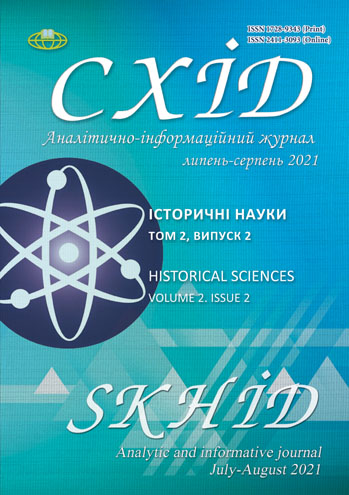DETERMINING THE NUMBER OF VICTIMS OF THE HOLODOMOR GENOCIDE OF 1932-1933 IN UKRAINE
DOI:
https://doi.org/10.21847/1728-9343.2021.2(2).239373Keywords:
Holodomor genocide of Ukrainians in 1932-1933, historical-statistical calculations, demographic calculations of real lossesAbstract
The article analyzes the state of counting the casualties of the Holodomor-genocide of 1932-1933 in Ukraine. In par-ticular, there are testimonies of German and Italian diplomats of the time, who received confidential information from Soviet officials, which formed the basis of the established diaspora statement about the casualties: “from 7 to 10 million”. It is noted that during Gorbachev’s Perestroika in the USSR, Moscow was forced to recognize the Holodomor in Ukraine and allowed to write about the loss of 3.5 million people. Modern Ukrainian demographers, who work for foreign grants, continue to support this figure with some clarifications. At the same time, the primary documents of the Ukrainian archives, thanks to the historical and statistical method, make it possible to establish the minimum number of casualties during the Holodomor-genocide of 1932-1933 at 7,117.6 thousand people, because the information has been perceived on the population of the UkrSSR as of early 1932 (32,680 thousand people) and those born in 1932-1933, which allows us to establish the presence of inhabitants of the city and village as of January 1, 1934 using updated materials of the All-Union Census of 1937 and human growth in 1934-1936 – only 26,815.8 thousand. And it should have been 33,853.5 thousand people. And the use of histor-ical-statistical method of calculation allows to reach the figure of 9.5 million in the UkrSSR. This is provided that the dead hungry Ukrainian peasants in Russia and Belarus, where they went for bread, and were shot by Soviet border guards or drowned in the Zbruch and the Dniester due to their inability to swim are counted; when the number of workers brought from the Soviet republics in 1932-1936 to the socialist new buildings of the UkrSSR, who were counted as its inhabitants during the All-Union census of 1937, etc., are established.
Of particular importance for establishing the probability of these losses is the reconstruction of the correspondence of the occupancy of the first grades of Ukrainian schools in 1932-1939 with the number of births in 1924-1931. Thus, in the Orativ, Tarashchansky, and Pereyaslavsky districts of the then Kyiv Region, after 1933, half or even less of 8-year-old children were admitted to school. The same picture was observed in all areas of the current Poltava Region. As in all primary schools in the Petrykivka district of the Dnipropetrovsk Region, where almost half of last year’s students of 1st-3rd grades, who continued their education from September 1, 1933, were not admitted – 1,883.
This comprehensive approach to the study has made it possible to establish the loss of children, which was not less than 4 million, and the total losses in the UkrSSR, using the historical and legal method, – more than 9 million people. More than 1 million losses of Ukrainians outside the UkrSSR should be added to these victims, which is a total of more than 10 million.
Downloads
References
Dovidnyk z osnovnykh statystychno-ekonomichnykh pokaznykiv hospodarstva rayoniv Kyyivskoyi oblasty (1933). Kharkiv (In Ukrainian).
Holodomor 1932 – 1933 rokiv v Ukrayini (2007). Dokumenty i materialy. Vol. 2. Kyiv (In Ukrainian)
Holodomor v Ukrayini 1932 – 1933 rokiv (2008). Za dokumentamy politychnoho arkhivu Ministerstva zakor-donnykh sprav Federatyvnoyi Respubliky Nimechchyny. Kyiv: Natsionalnyy instytut stratehichnykh doslidzhen. (In Ukrainian)
Horbachuk, V. (2010). Trydtsyat rokiv na Donbasi (shchodennykovi zapysy).1973 – 2004. Slovyansk. (In Ukrainian)
Kovalenko, Lydia and Manyak, Volodymyr (1991). 33rd: Famine. People's Book-Memorial. Kyiv: Radyanskyy pysʹmennyk (In Ukrainian)
Kulchytskyy, S. (1991). Tsina velykoho perelomu. Kyiv: Ukrayina. (In Ukrainian).
Levchuk, N.M. & Boryak, T.G. & Volovyna, K.V. & Rudnytsky, O.P. & Kovbasyuk, A.B. (2015). Losses of urban and rural population of Ukraine as a result of the Holodomor in 1932-1934: new estimates. Ukrainian Historical Journal. 4: 84-112. – http://resource.history.org.ua/publ/ UIJ _2015_4_7 (In Ukrainian)
Serhiychuk, V. (2018). Holodomor 1932 – 1933 rokiv yak henotsyd ukrayinstva. (Issue 2). Vyshhorod. (In Ukrainian)
Serhiychuk, V. (2020). V oboroni ukrayinskoyi pravdy (Issue 2). Vyshhorod. (In Ukrainian)
Serhiychuk, V. (2021, April, 14). Strashni tsyfry Holodomoru: chomu Hennadiy Yefimenko teper imenuye feykom svoye vidkryttya. Ukrayina moloda. https://www.umoloda.kiev.¬ua/number/3716/196/156246/ (In Ukrainian)
Tsaplin, V. (1989). Statistika zhertv stalinizma. Voprosy istorii, 4 (In Russian).
Volovyna, O. (2018, July, 13-14). Teror holodom: yak naukovo obhruntuvaty kilkist zhertv? Den (Kyiv) . https://day.kyiv.ua/uk/article/poshta-dnya/teror-golodom-yak-naukovo-obgruntuvaty-kilkist-zhertv (In Ukrainian).
Zhiromskaya, V. (2001). Demograficheskaya istoriya Rossii v 1930-e gody. Vzglyad v neizvestnoye. Moscow: ROSSPEN. (In Russian)
Downloads
Published
How to Cite
Issue
Section
License
Copyright (c) 2021 VOLODYMYR SERHIYCHUK

This work is licensed under a Creative Commons Attribution-NonCommercial-NoDerivatives 4.0 International License.
1. Authors bear responsibility for the accuracy of facts, quotations, numbers and names used.
2. Manuscripts are not sent back.
3. The publisher does not always agree with the authors' opinion.
4. The authors reserve the right to authorship of the work and pass the first publication right of this work to the journal under the terms of a Creative Commons Attribution-NonCommercial-NoDerivatives 4.0 International License. This license allows others to distribute (copy) the published work for non-commercial purposes, provided there is mandatory attribution to its authors and a link to the first publication in our journal.
5. The authors have the right to conclude separate supplement agreements that relate to non-exclusive work distribution in the form in which it has been published by the journal (for example, to upload the work to the online storage of the journal or publish it as part of a monograph), provided that the reference to the first publication of the work in this journal is included.

